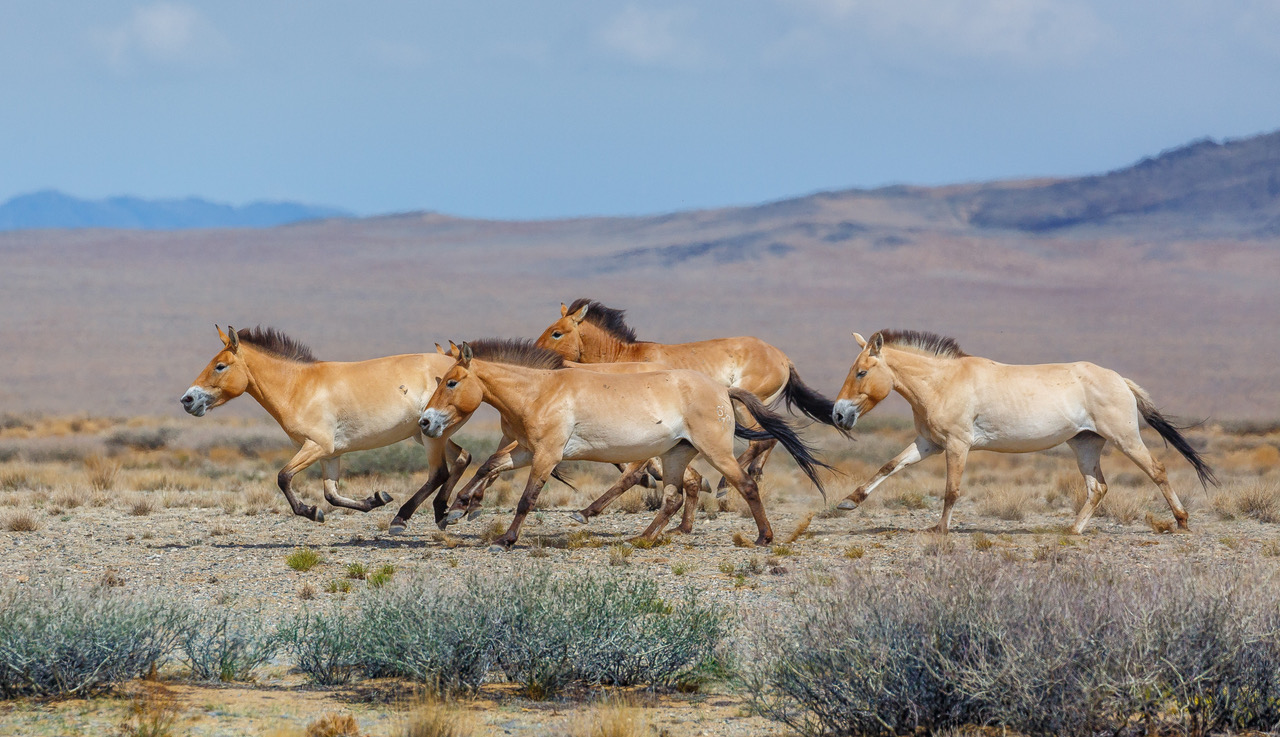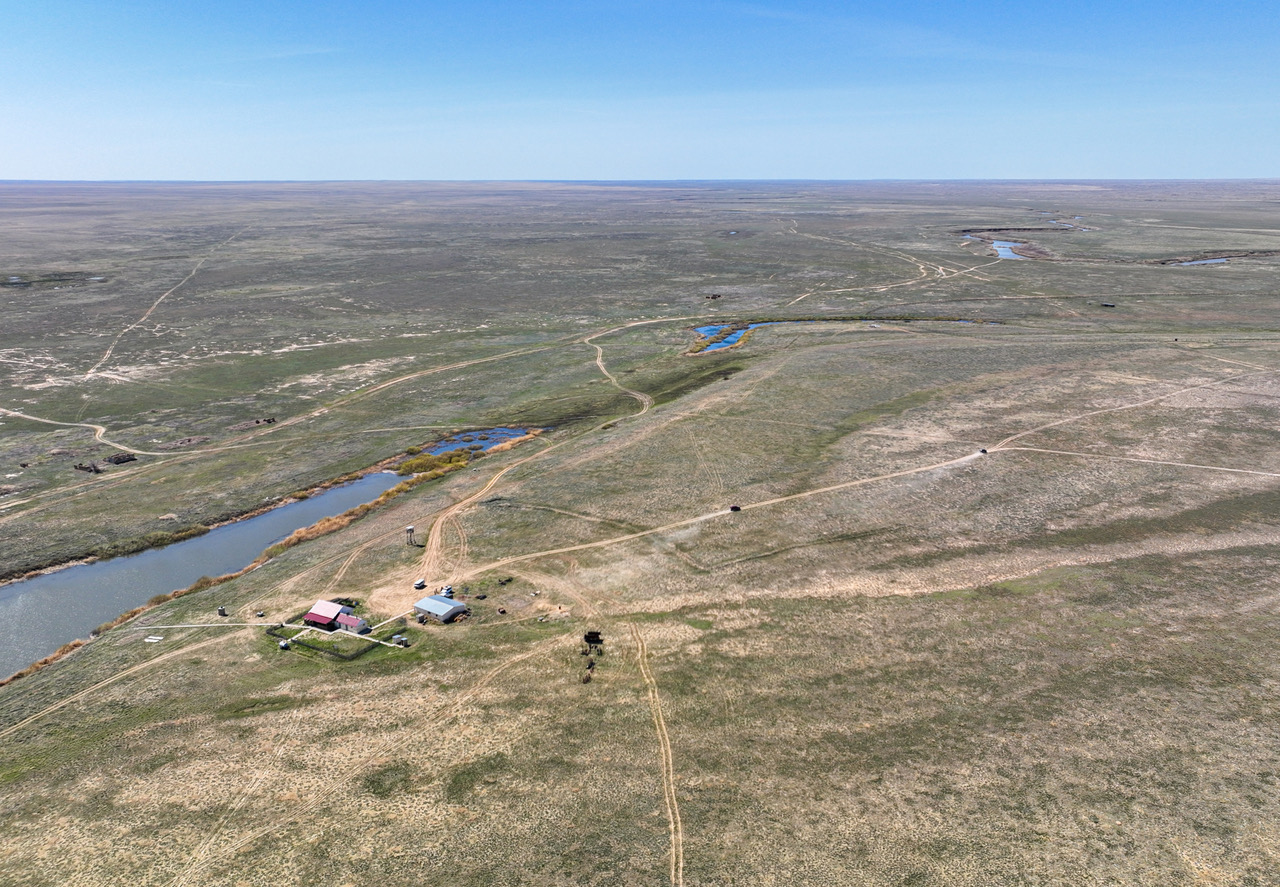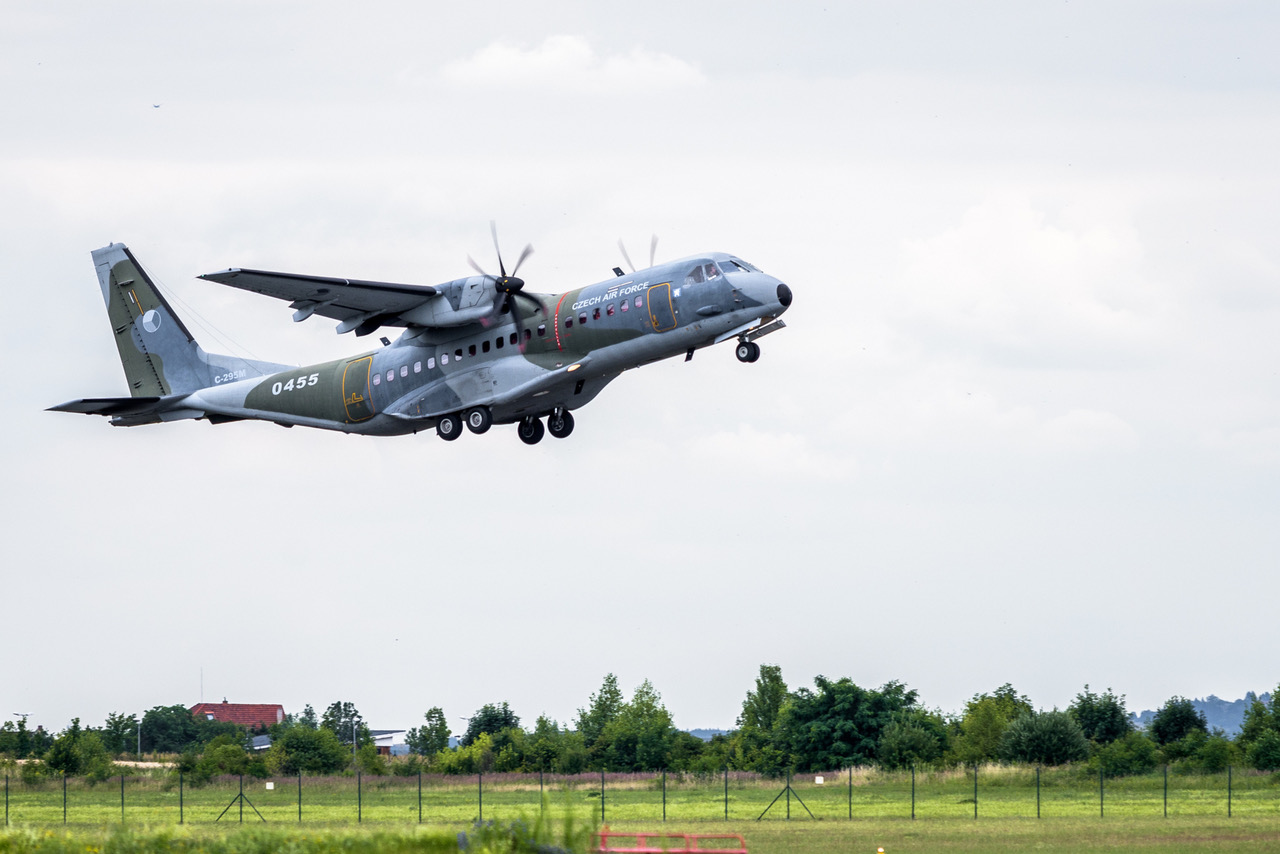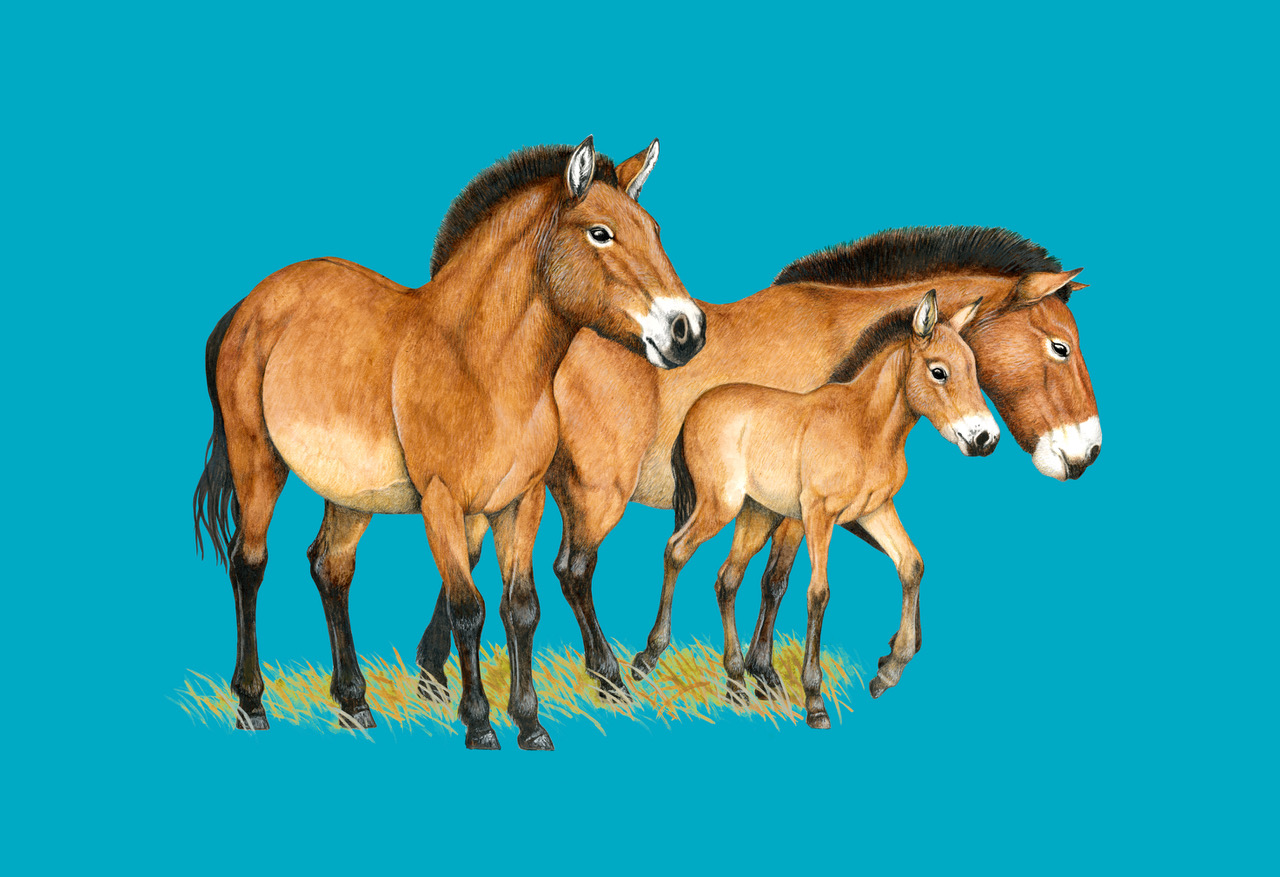
Převalský’s horses run through the landscape of their ancestors in the Great Gobi B Strictly Protected Area in Mongolia. Such a sight will soon be a reality in the Altyn Dala steppe in central Kazakhstan. Photo by Miroslav Bobek, Prague Zoo
The first transports of Převalský’s horses from Europe to Kazakhstan will take place this June as part of the Return of Wild Horses 2024 project. Two CASA army planes with a total of eight horses on board will take off from the airports in Prague and Berlin on June 3. After stopovers in Istanbul and Baku, they will land in Arkalyk in central Kazakhstan on June 4. Then the transport of the horses will continue to the Alibi acclimatization center in Altyn Dala by land. The last wild horse will thus return to the steppes of another country in the interior of Asia after Mongolia. Representatives of the Prague Zoo, the Army of the Czech Republic, the European Association of Zoos and Aquariums (EAZA), and the Frankfurt Zoological Society (FZS) announced this today at a press conference in Prague.
“After the transport of Převalský’s horses to Mongolia, we are starting to write a new chapter of the return of the last wild horse to the area of its original distribution,” said the director of the Prague Zoo, Miroslav Bobek. “In Kazakhstan, we have chosen the Altyn Dala region, i.e. the Golden Steppes, as the most suitable area for the reintroduction of ‘rollers’. Our intention is to transport at least 40 horses there over the next few years.”
Převalský’s horse disappeared from nature at the end of the 1960s. The Prague Zoo, which has been keeping his world stud book since 1959, played a significant role in his rescue in human care. She was also involved in the later return of Převalský’s horse to Mongolia; most notably nine transports to the west of the country between 2011 and 2019. Now, in addition to the return of the ‘rollers’ to Kazakhstan, the Prague Zoo is also preparing a project to reintroduce them to eastern Mongolia.

Aerial view of the Altyn Dala area and the Alibi reintroduction and acclimatization center. It is there that Převalský’s horses will get used to the local conditions after transport, before being released into the wild. Photo by Tomáš Hulík, Prague Zoo
“Převalský’s horse is an iconic animal representing a successful story of saving the species: extinct in the wild, rescued thanks to the zoo, returned to the place of original occurrence. For the European Association of Zoos and Aquariums, this is precisely one of the key aspects of progressive zoos, i.e. their involvement in EAZA Ex situ programs (EEP) and their ability to connect this with efforts to protect in situ, i.e. the protection of wild nature,” said the president in his speech EAZA Endre Papp.
The goal of the “Kazakhstan” project is to transport at least 40 Przevalsky horses to the Altyn Dala area within five years, which will form the basis of the local population. Their transport will be provided by the Prague Zoo in cooperation with the Army of the Czech Republic and other partners.
“We expect to transport three stallions and five mares from Prague and Berlin by two CASA C-295M aircraft of the Army of the Czech Republic. We will send four horses with one machine from Prague-Kbely military airport, the other four will be sent from Berlin by Tierpark Berlin. Both aircraft will take off on Monday, June 3, 2024 after noon,” said Brigadier General Jaroslav Falta, Commander of the 24th Transport Aviation Base at Prague-Kbely Airport.

CASA C-295M aircraft of the Army of the Czech Republic were used not only for the transport of Převalský’s horses to Mongolia, but also recently for the transport of the lowland gorilla Duni from Spain to Prague. This year, a total of eight Převalský horses will fly to Kazakhstan on two planes at the same time. Photo by Petr Hamerník, Prague Zoo
The planes will fly to Arkalyk Airport with stopovers in Istanbul and Baku. The plan is to land in Arkalyk on the morning of Tuesday, June 4, releasing the horses to the acclimatization pen in Alibi after their ground transport the same evening.
“We already built a basic infrastructure on the site years ago, which was mainly used for the reintroduction of Asian kulan donkeys. The Alibi Center will now serve another type of ungulate, and after the necessary modifications, it will become the gateway for Převalské horses to the Golden Steppe,” said Steffen Zuther, a researcher at the Frankfurt Zoological Society, in Prague today. In 2006, together with her partners, she founded the Initiative for the Protection of Altyn Dala, which strives for the comprehensive protection of the steppe ecosystems there.
The Return of Wild Horses project is financed from the We help them survive account, which – thanks to the City Hall city of Prague – CZK 8 from each ticket to the Prague Zoo goes, among other things.
“I am very proud of the Prague Zoo’s in situ projects, in which I personally see one of the main purposes of modern zoos. Everyone helps a good cause by visiting the Prague Zoo. I am even more pleased to see the attendance of the zoo so far, which has already received over 130,000 visitors this year,” said the deputy mayor in her speech . City of Prague for the environment Jana Komrsková.
Further information, photos for use in the media or logos of all partner organizations can be found in the clear press kit. Czech, English and Russian language versions are available for download here: www.zoopraha.cz/kazachstan-2024.

The visual of the Return of Wild Horses 2024 is based on the concept proven during the transport of Převalský’s horses to Mongolia. The author of the visual for the year 2024 is the Czech illustrator and naturalist Jan Dungel. He captured a group of Przewalski’s horses, which is supposed to symbolize the target state of the project – a functioning population of Przewalski’s horses in Altyn Dala. The background color is based on the colors of the flag of Kazakhstan. Source: Prague Zoo
A memorandum of cooperation between all institutions involved in the project was signed last week, February 28, in Astana, Kazakhstan.
Institutions and entities collaborating on the project
The Prague Zoo maintains the World Stud Book of the Převalský horse as well as its EEP (EAZA Ex situ program = European breeding program). After World War II, she played a vital role in saving Převalský’s horse. Later, she came up with the idea of its reintroduction, in which she subsequently got involved. Her nine transports of Převalský’s horses from Europe to Western Mongolia were very significant. Now, in addition to preparing the transport of Převalský’s horses to Kazakhstan, he is preparing a reintroduction project for Eastern Mongolia.
The Forestry and Wildlife Committee (FWC) is a state department under the Ministry of Ecology and Natural Resources of the Republic of Kazakhstan. Its task is the management and protection of nature and specially protected areas. It was his call to the Prague Zoo in the fall of 2022 that initiated the start of the project to reintroduce Převalský’s horses to Kazakhstan.
The Association for the Protection of Biodiversity of Kazakhstan (ACBK) is a national public association aimed at preserving biodiversity and educating the population. In a broader perspective, the Return of Wild Horses project is part of her long-term effort to reconstruct the original steppe communities in the country. ACBK is behind building the necessary infrastructure in the Altyn Dala State Nature Reserve. This was used in the past for the reintroduction of kulans in cooperation with the Frankfurt Zoological Society.
Tierpark Berlin is a zoo that has already participated in the breeding, management and reintroduction of various animal species in the past, while also cooperating in the protection of the Převalské horse. As part of the Return of Wild Horses project, it provides horses from its breeding facility, brings candidates from other European institutions to its breeding facility and will directly participate in their transport to Kazakhstan.
The Frankfurt Zoological Society (FZS) is an international organization coordinating projects for the protection of endangered species and ecosystems in 18 countries. In Kazakhstan, he participates in the protection of Tatar or Kulan saigas. In 2006, she co-founded the Altyn Dala Conservation Initiative (ADCI).
Nuremberg Zoo (Tiergarten Nürnberg) is a public non-profit zoo focusing on the ex situ protection of endangered animal species and their in situ protection in cooperation with partners in their countries of origin. In the past, she participated in the reintroduction of Převalský horses to Central Asia.
The Hortobágy National Park has already participated in the reintroduction of Převalský’s horses in the past, including in cooperation with the Prague Zoo. Currently, the largest population of Převalský’s horse lives on its territory outside the area of its original occurrence. Selected horses from this park will also be candidates for transport to Kazakhstan.
The Air Force of the Army of the Czech Republic , specifically the 24th Transport Air Force base based at Prague-Kbely Airport, ensures the transport of horses to Kazakhstan. They have also collaborated with Prague Zoo in the past, among other things, on the transport of a gorilla or nine transports of Převalský’s horses to Western Mongolia between 2011 and 2019.

